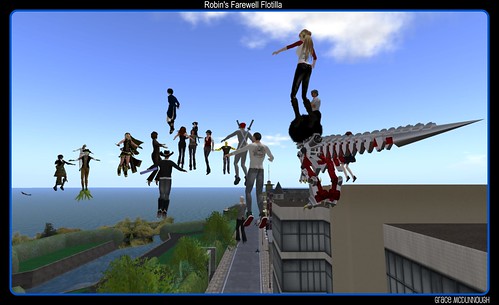I'm going to open with a disclaimer: this may be a rambling, personal post in the way I imagined "Phasing Grace" would always be - a summary of what's phasing Grace - were it not for my simple insecurities and tendency toward "perfectionism" and some self imposed rule that posts should be deep, well thought out and structured as if they were going to be graded by Mrs. Jones - my 9th grade AP English teacher.
Those things have weighted me down long enough to where I have gone weeks without posting even a salient point that is otherwise lost, all for want of approval or correctness. So if a glimpse into my here and now mind scares you (and by all accounts, it should) then have a look elsewhere for now, although my suspicions are that henceforth, Phasing Grace will rediscover and embrace its original intentions so if you can, please stick around.
So today, the things that phasing Grace are largely but not surprisingly about identity.
Let's start with the first thing that caught my eye, a newly minted Wallace Linden's "conversation starter" post entitled "
Will the Real You Please Stand Up". Provocative headline notwithstanding, the post tries to state a seemingly straightforward question:
What are the issues attendant to virtual identity management? People have spent entire lifetimes researching this question; I'm sure Wallace didn't expect to work it out in his inaugural post but he certainly touched a nerve of the Second Life Residents, at the time of this post, it has 375 comments and few are of the "nice post, thanks buddy" variety.
Wallace's post appears to place a high value on name spaces as a means by which to traverse a person's digital droppings, and avoids exploring a more meaningful identity construct that extends beyond a mere user name. This is actually somewhat ironic as a precursor to a major Linden Lab announcement just nine days later, the acquisition of
Avatars United.
Avatars United is described by M Linden as a Web-based community site designed especially for avatars. My personal Avatars United account was over a year old and primarily inactive because the service afforded very little outside of what established services such as
flickr,
twitter,
plurk, and
Facebook provided but the acquisition may prove to be a means to broaden the reach of Second Life on the whole by raising awareness across gaming and virtual world platforms.
But why is it ironic you ask?
Well primarily because for all the goodness Avatars United might bring the to the Second Life ecosphere, it failed to protect one tiny thing that Wallace lauded: your Second Life name space. Avatars United,
now prominently promoted as part of Second Life, has no means to verify your valuable Second Life name.
I cannot be anyone other than Grace McDunnough on XStreetSL and there can be only one Grace McDunnough in Second Life, but on Avatars United anyone
and everyone can be Grace McDunnough anywhere and everywhere. Consequently, on Avatars United the virtual identity name space Grace McDunnough has been devalued.
Ordinal Malaprop was the first person that made
this clearly obvious. Let me state my short opinion:
this is bad ju-ju.
Why does this make me crazy?
For Second Life, I selected my name very carefully. Using the clumsy interface that the Lab affords new registrants, I picked Grace first, then looked for something vaguely Scottish or Irish. I wanted Grace to be a uniquely named person with traces of me; I diligently searched
Grace McDunnough to see if there were any potential identity collisions. I found two: J. McDunnough, a Canadian Entomologist fascinated with classifying butterflies, and H.I. and Edwina McDunnough in the Coen brother's film Raising Arizona, both of which sort of sealed the deal for me in some weird way.
On February 6, 2006 Grace McDunnough became little more than 15 identity characters on a screen wandering aimlessly down the Orientation path, wearing a purple t-shirt and jeans, talking to a parrot and picking up a torch to light the way to the new world.
Since then, the user name Grace McDunnough has become my digital fingerprint in every virtual space I reside and my identity has real value outside of those 15 characters. I made a steadfast decision that I would not use my "real life" identity in any way to alter, shape, drive, etc. my eventual identity as Grace. I wanted Grace to develop her own street cred. I also chose not to gender bend or role play, but rather simply be the person I could not be in my day-to-day existence - more of an artist than a technologist - more of a philosopher than a executioner - more of an ENTJ than an INTJ.
Every instance, every action, every aspect of the virtual identity Grace McDunnough are important to me and as we move closer to the reality of the networked society they
hold immeasurable value. Do not devalue them with a clumsy deployment.
Finally, this week my schedule allowed me time to participate in a great conversation with The Thinkers group in Second Life about identity and reputation. The discussion came on the heels of a post by Extropia DaSilva on Gwyn's blog entitled "
Digital People and Anonymous Avatars". The discussion was to be pivoted on Scope Cleaver and his work in Second Life as a builder and what it takes to develop an online reputation. This strikes a deep chord for me because if it were not for Second Life, the music of Grace McDunnough would never be heard.
The most interesting and perhaps the most troubling part of the discussion was about how the work of a person that does not provide offline credentials holds little to no value. So beyond trust, which is another ongoing debate among scholars, a person's work in a virtual space may actually be of less value than someone who holds real life credentials.
To me, this will stifle any hope of realizing any of the new economic potential outlined in Yochai Benkler's book "
The Wealth of Networks" simply because the opportunities for people to participate are cut off by the very limitations we are trying to supersede.
As a 4th year rez day approaches I am even more keenly
aware and appreciative of the power, the nature and the delicate intricacies of digital identity. In fact, I may blurred in my thinking because this topic is so passionately appealing to me but I might go so far as to suggest the following:
The single most unappreciated element of Second Life is identity because in the end, a virtual identity is a commodity with tangible value.
That perspective, which may be solely my own, is the lens through which I have viewed my entire existence within Second Life. It's how I evaluate what Linden Lab does or doesn't do, it's how I process the events that occur and to some extent it is how I (and maybe others) start evaluate my self worth.
What do you think?
Is the fluff over Avatars United without merit?
Does your identity have value?
Do real life credentials increase the value of your work online?
Share Some Grace:
 One book I finished was Simon Sinek's "Start With Why". I ran across Simon's TED Talk "How Great Leaders Inspire Action" (also the subtitle to his book) and was left wanting more, so I grabbed a copy of his book.
One book I finished was Simon Sinek's "Start With Why". I ran across Simon's TED Talk "How Great Leaders Inspire Action" (also the subtitle to his book) and was left wanting more, so I grabbed a copy of his book. 









![Reblog this post [with Zemanta]](http://img.zemanta.com/reblog_e.png?x-id=bf2ce0af-6bdb-4dd7-8273-4c04e6bd73d3)





![Reblog this post [with Zemanta]](http://img.zemanta.com/reblog_e.png?x-id=2154d5b0-ab81-4231-8823-506ce625ea39)

![Reblog this post [with Zemanta]](http://img.zemanta.com/reblog_e.png?x-id=20e7d06f-8578-405c-9d15-c2467f40cd59)